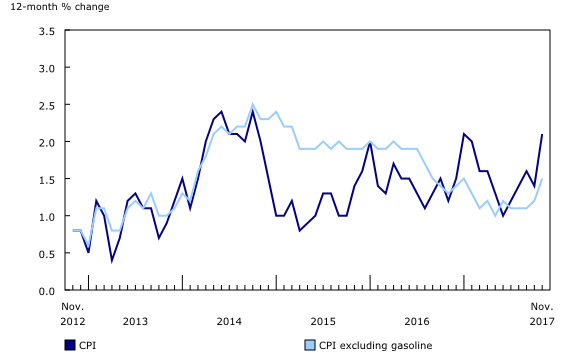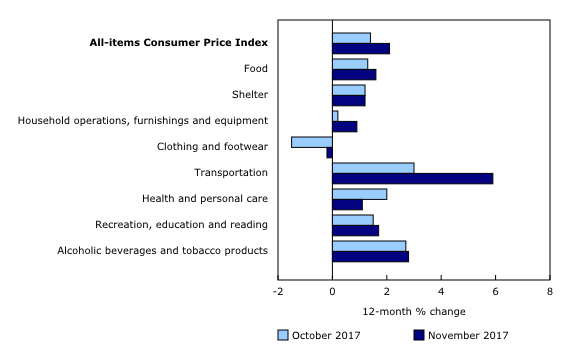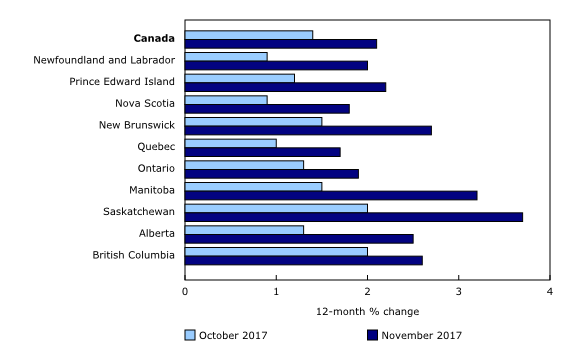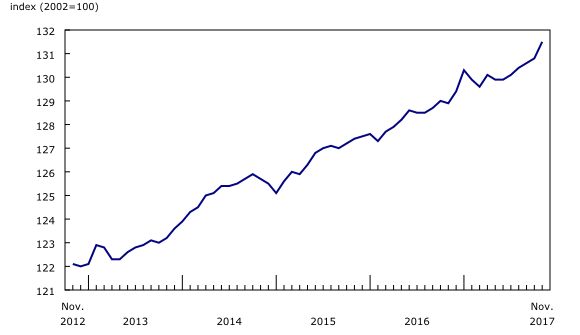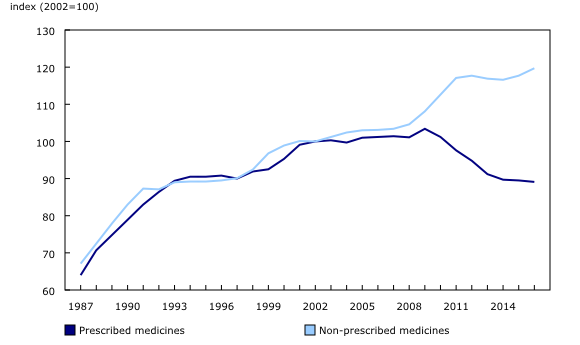Consumer Price Index, November 2017
Archived Content
Information identified as archived is provided for reference, research or recordkeeping purposes. It is not subject to the Government of Canada Web Standards and has not been altered or updated since it was archived. Please "contact us" to request a format other than those available.
Released: 2017-12-21
November 2017
2.1% 
(12-month change)
The Consumer Price Index (CPI) increased 2.1% on a year-over-year basis in November, following a 1.4% increase in October. The all-items excluding gasoline index rose 1.5% year over year in November after increasing 1.3% in October.
12-month change in the major components
Prices were up in seven of the eight major CPI components in the 12 months to November, with the transportation and shelter indexes contributing the most to the increase. The clothing and footwear index declined on a year-over-year basis.
Transportation prices rose 5.9% on a year-over-year basis in November, following a 3.0% increase in October. Gasoline prices contributed the most to this acceleration, rising 19.6% year over year in November, after increasing 6.5% the previous month. The increase was partly attributable to higher crude oil prices in November, as well as a monthly decline one year earlier. The purchase of passenger vehicles index also accelerated to 3.6% on a year-over-year basis in November, following a 1.9% rise in October. The November increase was partly attributable to the greater availability of new 2018 model year vehicles.
The food index rose 1.6% year over year in November following a 1.3% increase in October. On a month-over-month basis, the food index rose 0.8% in November, the largest monthly gain since January 2016. Prices for meat were up 1.9% on a year-over-year basis in November after a 0.1% increase in October. Fresh vegetable prices rose 3.8% in the 12 months to November.
Consumer prices for household operations, furnishings and equipment rose 0.9% on a year-over-year basis in November after increasing 0.2% in October. The November increase was driven by growth in the telephone services index (+2.3%) which was partly attributable to a decline in prices in November 2016, which no longer influences the 12-month movement. Furniture prices increased 1.9% month over month, the largest monthly increase since February 2015.
12-month change in the provinces
Consumer prices rose more on a year-over-year basis in every province in November than they did in October. Manitoba (+3.2%) and Saskatchewan (+3.7%) recorded the largest accelerations.
The gasoline index contributed the most to the rise in the CPI in every province except for Newfoundland and Labrador, where a lower gasoline price increase was partly attributable to a reduction in the province's gasoline tax which took effect in June 2017.
The CPI in Manitoba rose 3.2% in November on a year-over-year basis, after increasing 1.5% in October. The furniture index rose the most in Manitoba in the 12 months to November. The household equipment index rose 2.6% on a month-over-month basis in November, more than in any other province.
Consumer prices in Alberta increased 2.5% in the 12 months to November, after a 1.3% gain in October. Among the provinces, gasoline (+30.0%) increased the most in Alberta. Electricity prices were up 17.5% in November after increasing 9.3% in October. The November gain was largely attributable to rate decreases in November 2016, which no longer factor into the 12-month movement.
The CPI rose 1.7% in Quebec in November on a year-over-year basis, after increasing 1.0% in October. Food prices increased 1.1% month over month, the largest increase among the provinces. Consumers paid higher prices for fresh vegetables (+5.7%) year over year in November.
Seasonally adjusted monthly Consumer Price Index
On a seasonally adjusted monthly basis, the CPI rose 0.5% in November. This was the largest increase since January 2017.
In November, seven major components increased, while the health and personal care index (-1.0%) declined.

In celebration of the country's 150th birthday, Statistics Canada is presenting snapshots from our rich statistical history.
Prescribed and non-prescribed medicines represent 1.27% of the 2015 Consumer Price Index (CPI) basket. These indexes, first introduced to the CPI in 1985, track the prices of medicines prescribed by doctors and those purchased over the counter.
The indexes for prescribed and non-prescribed medicines moved relatively in tandem for the first two-plus decades following their introduction. From 1987 to 2009, the average annual growth of both the prescribed and non-prescribed medicines price indexes was 2.6%. In the late 2000s, patents expired on a significant market share of prescription drugs and lower cost generic replacements entered the market, driving down prescription drug prices. From 2010 to 2016, the prescribed medicines index decreased 2.1%, while prices for the non-prescribed medicines index grew 1.5%.
Note to readers
A seasonally adjusted series is one from which seasonal movements have been eliminated. Users employing Consumer Price Index (CPI) data for indexation purposes are advised to use the unadjusted indexes. For more information on seasonal adjustment, see Seasonally adjusted data – Frequently asked questions.
Real-time CANSIM tables
Real-time CANSIM table 326-8023 will be updated on January 8, 2018. For more information, consult the document Real-time CANSIM tables.
Next release
The CPI for December 2017 will be released on January 26, 2018.
Products
The November 2017 issue of The Consumer Price Index, Vol. 96, no. 11 (62-001-X) is now available.
More information about the concepts and use of the Consumer Price Index (CPI) is available in The Canadian Consumer Price Index Reference Paper (62-553-X).
For information on the history of the CPI in Canada, consult the publication Exploring the First Century of Canada's Consumer Price Index (62-604-X).
Two videos, "An Overview of Canada's Consumer Price Index (CPI)" and "The Consumer Price Index and Your Experience of Price Change," are available on Statistics Canada's YouTube channel.
Contact information
For more information, or to enquire about the concepts, methods or data quality of this release, contact us (toll-free 1-800-263-1136; 514-283-8300; STATCAN.infostats-infostats.STATCAN@canada.ca) or Media Relations (613-951-4636; STATCAN.mediahotline-ligneinfomedias.STATCAN@canada.ca).
- Date modified:


